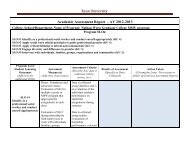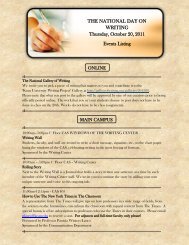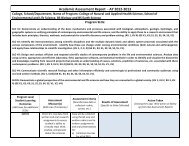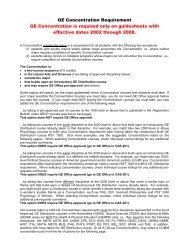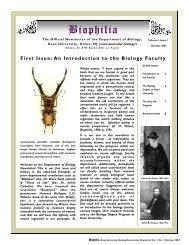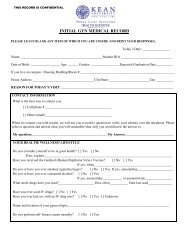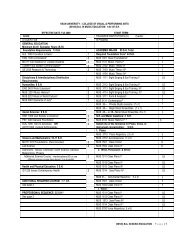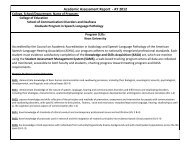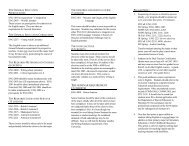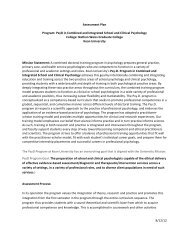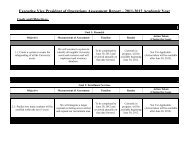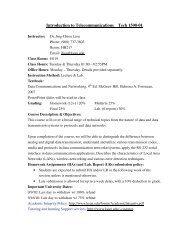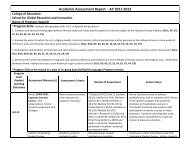ASAM Dimension
ASAM Dimension
ASAM Dimension
Create successful ePaper yourself
Turn your PDF publications into a flip-book with our unique Google optimized e-Paper software.
Assessment<br />
Clinical Steps<br />
To ensuring the needs<br />
Of your clients are<br />
Identified
Session Objectives<br />
�� Learn what the best strategies are to determine<br />
which potential drug court clients are most suitable<br />
for your program.<br />
�� Learn the best strategies for how to identify the<br />
needs of your drug court participants.<br />
�� Understand how to develop and assessment<br />
protocols for your drug court.
Assessment<br />
• Is an objective, strengths-based strengths based bio-<br />
psycho-social psycho social clinical evaluation that<br />
clarifies the nature and extent of an<br />
alcohol/drug use/abuse/addiction<br />
disorder.<br />
• The outcome of an effective assessment<br />
is a diagnoses and referral to the most<br />
appropriate level of care of treatment<br />
services.
Goals of Assessment<br />
• Examine the scope and nature of the subject’s<br />
substance abuse problem.<br />
• Understand the impact substance abuse has had<br />
on the individual.<br />
• Define major areas of strengths and deficits.<br />
• Identify problems in all other life domains to be<br />
addressed in treatment.<br />
• Identify the full range of service needs, pursuant<br />
to treatment planning.<br />
• Match participants to appropriate LEVELS and<br />
TYPES of substance abuse services.<br />
US Department of Justice, Office of Justice Programs, Drug Courts Courts<br />
Program Office; Guideline for
Assessment<br />
What tools are you required to<br />
use for assessment?<br />
*State State Licensing Requirements<br />
*National National Accreditation<br />
�� Note: Do they assist in developing a DSM-IV DSM IV diagnosis? Are they<br />
tied to a criteria for the appropriate level of care placement<br />
(<strong>ASAM</strong>)?
Valid and Reliable Clinical<br />
Assessment Tools<br />
�� Global Assessment of Individual Needs<br />
(GAIN)<br />
�� Addiction Severity Index (ASI)<br />
�� Standard Bio-Psycho Bio Psycho-Social Social (often<br />
internally developed by agency)
Addiction Severity Index<br />
(ASI)<br />
�� Perhaps the best known, most used AOD<br />
assessment tool<br />
�� Six subscales – medical, AOD, employment,<br />
legal, family, psychiatric<br />
�� Rating of severity in each subscale<br />
�� Standardized, training manuals and training<br />
available
Evidence-Based<br />
Evidence Based<br />
Assessment Tools<br />
Include Several Domains<br />
Which Can Be Correlated With<br />
<strong>ASAM</strong> Criteria for<br />
Making Placement Decisions
<strong>ASAM</strong> PPC-2R PPC 2R <strong>Dimension</strong>s<br />
<strong>Dimension</strong> 1- 1 Acute Intoxication and/or<br />
Withdrawal Potential<br />
<strong>Dimension</strong> 2- 2 Biomedical Conditions and<br />
Complications<br />
<strong>Dimension</strong> 3- 3 Emotional, Behavioral, and<br />
Emotional Conditions & Complications<br />
<strong>Dimension</strong> 4- 4 Readiness to Change<br />
<strong>Dimension</strong> 5- 5 Relapse, Continued Use, or<br />
Continued Problem Potential<br />
<strong>Dimension</strong> 6- 6 Recovery/Living Environment
Alcohol/Drug Use Use<br />
�� Needs and Strengths are Measured<br />
Correlates to:<br />
�� <strong>ASAM</strong> <strong>Dimension</strong> 1- 1 Acute Intoxication<br />
and/or Withdrawal Potential<br />
�� <strong>ASAM</strong> <strong>Dimension</strong> 5- 5 Relapse,<br />
Continued Use or Continued Problem<br />
Potential
Criminal Criminal Involvement<br />
�� Needs and Strengths are Measured<br />
Correlates to:<br />
�� <strong>ASAM</strong> <strong>Dimension</strong> 3- 3 Emotional,<br />
Behavioral, & Cognitive Conditions &<br />
Complications<br />
�� <strong>ASAM</strong> <strong>Dimension</strong> 6 - Recovery<br />
Environment
Medical Medical Status Status<br />
�� Needs and Strengths are Measured<br />
Correlates to:<br />
�� <strong>ASAM</strong> <strong>Dimension</strong> 2: Biomedical<br />
Conditions and Complications
Psychiatric Status Status<br />
�� Needs and Strengths are Measured<br />
Correlates to:<br />
�� <strong>ASAM</strong> <strong>Dimension</strong> 3- 3 Emotional,<br />
Behavioral, & Cognitive Conditions &<br />
Complications
Employment and and Financial<br />
Status Status<br />
�� Needs and Strengths are Measured<br />
Correlates to:<br />
�� <strong>ASAM</strong> <strong>Dimension</strong> 6 - Recovery<br />
Environment
Family Family and and Social Social Status Status<br />
�� Needs and Strengths are Measured<br />
Correlates to:<br />
�� <strong>ASAM</strong> <strong>Dimension</strong> 6 - Recovery<br />
Environment
Alcohol/Drug Triggers Triggers<br />
and and Cognitions<br />
�� Needs and Strengths are Measured<br />
Correlates to:<br />
�� <strong>ASAM</strong> <strong>Dimension</strong> 5- 5 Relapse,<br />
Continued Use or Continued Problem<br />
Potential
Self--Efficacy Self Efficacy and and Motivation<br />
for for Change Change<br />
�� Needs and Strengths are Measured<br />
Correlates to:<br />
�� <strong>ASAM</strong> <strong>Dimension</strong> 4- 4 Readiness to<br />
Change
Assessment Leads Leads to to<br />
Placement<br />
�� Assessments of addiction severity<br />
�� Assessment of problems and strengths<br />
�� Comparison to <strong>ASAM</strong> Placement Criteria<br />
SHOULD CULMINATE IN A PLACEMENT<br />
THAT IS LEAST INTENSIVE/RESTRICTIVE<br />
FIRST AND THEN INTENSIFIED AS<br />
CLINICALLY INDICATED
Resources<br />
Allen JP & Wilson VB (Eds.) (2003). Assessing alcohol<br />
problems: A guide for clinicians and researchers (2nd ed.)<br />
[No. 03-3745]. 03 3745]. Bethesda, MD: NIAAA.<br />
Inciardi JA (Ed.) (1994). Screening and assessment for<br />
alcohol and other drug abuse among adults in the criminal<br />
justice system [TIP No. 7]. 7] . Rockville, MD: CSAT.<br />
Rounsaville BJ, Tims FM, Horton, AM & Sowder BJ<br />
(Eds.) (1993). Diagnostic source book on drug abuse<br />
research and treatment [No. 93-3508]. 93 3508]. Rockville, MD:<br />
NIDA.<br />
American Society of Addiction Medicine. Patient Placement<br />
Criteria for Treatment of Psychoactive Substance Use<br />
Disorders, 2 nd ed. Washington, DC: American Society of<br />
Addiction Medicine, 1996



